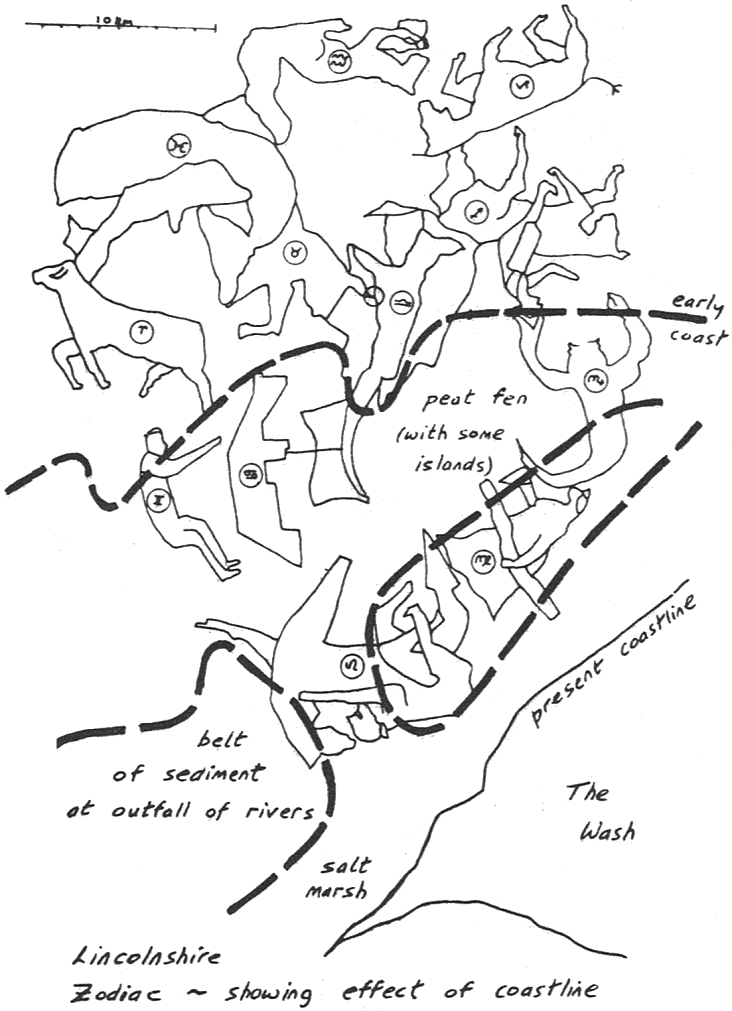
Journal of Geomancy vol. 4 no. 1, October 1979
{25}
I do not relish being the one to pour cold water on the Lincolnshire Zodiac described in JOG 3/4 but it does not seem to bear up to scrutiny, unless there is a wealth of supportive evidence not mentioned. At the risk of misjudging any research which went into the contribution it looks to me as if a Taurus figuration was conjured up near a Horncastle reference and the rest followed from there. Taurus is not actually depicted at Horncastle itself, and the horn at Horncastle relates to the peninsula formed by a junction of two rivers, being derived from the Celtic horn, meaning a corner of land surrounded by water. Although it was the site of a troytown maze, that horn plays no part in the zodiac, being located on the belly of the Dolphin.
With one or two exceptions the figures bear little resemblance to the landscape. What struck my attention in particular though was the location of part of the {26} zodiac in an area which was below sea level at the time when we suppose the figures to have been set out. Indeed the rather straight proportions of the Argo Navis, together with part of Gemini, are represented by drains which were only cut by engineers in the last two centuries, and anyone with knowledge of the area would appreciate that, whatever differing theories there may be regarding the actual position of the coastline, these features are of a new rather than an ancient landscape.

Asgarby (Asgeriby at Domesday, and interpreted as heaven in the article) is one of the many villages in that area with sacred origins to their names, but this is not necessarily connected with a zodiac. An Asgarby elsewhere in Lincolnshire and the Aswardby on the tail of Sagittarius’ horse are derived from Asuuardebi, from the Celtic as (god) war (above) de (worship).
I would have expected names to reflect to some degree the particular aspect of the zodiac, rather than be general indications of a pagan culture where worship of a deity was a more important part of the way of life.
It may he that something was lost in the printing, but the Leo feature described as Wilberton is actually Wyberton (pronounced Wibberton) which is traditionally said to derive from Wybert, who was killed fighting for the Earl of Mercia against the Danes in 870 CE. It could also be from the Celtic wy (river) ber (fort) built before the Roman evacuation, but this is less likely if the outfall of the River Witham was some miles to the north-west, settlement taking place on the sediment lands only in the 7th and 8th centuries CE. The legend surrounding the wind at Boston Stump is one common to Lincoln Cathedral and I believe many other churches as an explanation of the physical effects of the building.
I apologize if I have jumped to conclusions, and should welcome more elaboration from the contributor. If the zodiac can be substantiated, in fact nothing would please me more, by detailed corroborative evidence. In particular I was interested in the possibility of other figures, as I have been half expecting to find some figure, possibly a Scorpio or Sagittarius (to continue zodiac metaphors) to the north-east of the zodiac area, between Capricorn and Aquarius positions, in connexion with local dragon legends. I should also welcome contact from other Lincolnshire geomants to carry out joint research.
Andrew Pickering, Lincolnshire Earth Mysteries Research, Address, Boston, Linc.